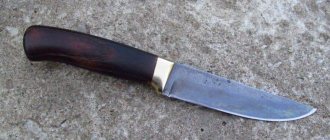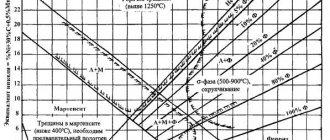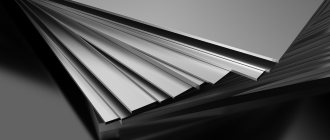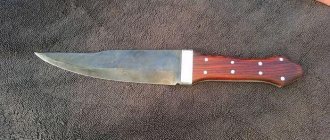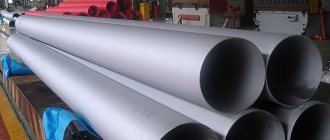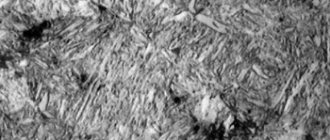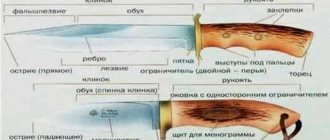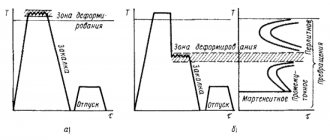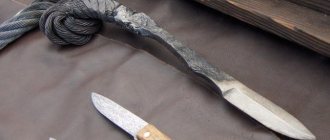Decoding steel U8
U8 includes the following components:
These are the main components, in addition to them, nickel, manganese and others are present in this alloy.
U8 is classified as a tool carbon steel. The properties of the alloy, which are provided by the substances included in its composition, make it possible to produce from it a tool that can work in conditions where the cutting edge does not overheat.
As a rule, this material is used for the production of hand-held thread-cutting tools - complete taps, dies for manual work, etc. In addition, tools for wood processing are successfully produced from this steel.
Among domestic analogues of U8 steel, U7 and U10 can be named. Foreign analogues include 1080, 1070. They are often used for making swords. And for the production of knives, 1095 is used.
But there is another area of use of this material - the manufacture of bladed weapons, in particular, survival knives, which are in great demand among tourists, hunters, and fishermen.
In fact, steel of this brand can be safely called a classic of the genre.
The presence of carbon in its composition ensures high hardness and, accordingly, the quality of sharpening, that is, the knife retains its sharpness for a long time. In addition, survival knives made of U8 steel can serve other roles, for example, a crowbar or an ax. Using such a knife, you can perform simple installation operations, for example, opening a hatch.
The best steel grades for knives
Depending on the percentage of carbon in the alloy, steel is divided into three types: high-carbon, medium-carbon, low-carbon. If the alloy contains other chemical elements, it is called alloyed. If the percentage of alloying elements that change its properties is from 10 to 50, the steel is highly alloyed. Since when chemical elements are added to a steel alloy, its composition can change, this suggests that while some qualities of steel increase, others may not change for the better. Therefore, it is difficult to say unequivocally which steel grade is the best. Rather, the best characteristics of a knife depend on the quality of the heat treatment of the blade, the technology of which varies among different manufacturers.
U8 – classic knife steel
Grade U8 is classified as eutectoid steel. That is, the presence of pure carbon is equal to that found in perlite cementite. This means that the steel contains no secondary carbides. This led to the emergence of a number of subtleties that arise when working with U8 steel and its analogues.
For example, in the composition of U8, their absence guarantees the presence of a homogeneous structure; steels of this type are well processed by forging welding. That is why these alloys are included in Damascus steels. But it is also necessary to remember that the absence of carbides complicates the heat treatment process. In particular, a change in the optimal hardening temperature by several degrees leads to a decrease in mechanical properties, namely strength and toughness.
Preliminary heat treatment is also important. Its task is to optimize the structure immediately before hardening. It should be noted that steel grade U8 and its analogues have low hardenability and, as a result, are very sensitive to the length of the cooling delay time.
In 1997, GOST R 51015-97 was developed and put into effect in our country. He divides all knives into two large groups:
The first group includes products that are used to work with bread and vegetables. The second group includes knives intended for processing meat. This group also includes products intended for tourists, etc.
The same document defines the material from which knife products are made - this is U8A or U10A. Index “A” means that these are steels of improved quality; they have a reduced content of phosphorus and sulfur. Rods and strips made of U8A steel are used as workpieces.
GOST specifies that the surface hardness should be at the level of 49 HRC, but at the same time, the production of knives with a surface hardness of 41.5 HRC is also allowed.
Steel group U8 allows you to maintain the parameters defined in GOST R 51015-97.
Undoubtedly, in addition to the described material, the use of other steel alloys, for example, 40X13 or 65X13, is also permissible. The use of these alloys makes it possible to obtain knives with high strength and corrosion resistance. But the use of steels of this kind makes it possible to obtain products that have high strength and resistance to dullness, of course, when using knives for their intended purpose. But with a sharp impact, it is possible to get chips or cracks on the body of the blade. The presence of a large number of alloying elements can lead to increased fragility of the blade.
Read also: Melting furnaces for metal
Knives made from the U8 family have virtually no alloying components; GOST specifies that the presence of chromium should not exceed 0.2%, nickel and copper should not exceed 0.25%
pros
The advantages of steel grade U8, which is defined by GOST R 51015-97 as the main one for the production of utility and household knives, include the following - after heat treatment, it acquires sufficient strength and surface hardness sufficient to ensure the sharpness of the knife for a long service life. The blade tip can be refilled relatively easily, that is, ordinary abrasive stones can be used for this. Such a knife is difficult to break upon impact.
Minuses
But the undoubted disadvantage is low resistance to corrosion. In other words, knives made from U8 require constant care. That is, after work, the blade must be wiped dry, or it is better to apply a layer of a protective agent, for example, some kind of oil.
98 Forging temperature, °C: beginning 1180, end 800. Sections up to 100 mm are cooled in air, 101-300 mm in a pit. Quenching 780-800 °C, water Interpretation of steel grade U8A: the letter U indicates that this is unalloyed tool steel, and the letter A indicates that this is high-quality steel, which contains carbon in an amount of 0.8%. Tools made of U8A steel and its heat treatment: circular saws are made from steels 85ХФ, 65Х, У8А, ШХ6. All woodworking tools produced by forging or stamping are annealed before machining. To heat the saws, they are loaded into an oven at the required temperature. After heating, they are quenched in oil in a vertical position. When the saw has cooled to approximately 300-400°, it is removed and clamped between two hardening plates until final cooling. Thin saw blades can be hardened between hollow, well-cooled hardening plates. To release the saws, they are compressed with clamps and in this position placed in an oven heated to a temperature of 450-500° and kept for 1.5-3 hours. To better straighten the saw during vacation, tighten the bolts of the clamp by removing it from the oven for a short time. Required hardness Rc = 40-42. For the manufacture of collet chucks, according to GOST instructions, U8A steel is also used. In addition to this steel, factories also use U7A, U10A, 65G, 4ХС, 9ХС steels and, in some cases, low-carbon steel with subsequent carburization. The hardness of the working (clamping) part of the collet chuck is Rc = 58-62, and the spring part (shank) is Rc = 40-45. In cemented collets, the hardness can be increased accordingly by 2-3 units. In collet chucks made of carbon steel, the specified combination of hardness is achieved by hardening the working part in water, followed by cooling the entire chuck in oil. The exposure in water for a collet with an internal diameter of 5-8 mm is 2-3 seconds. Alloy steel collet chucks are completely hardened in oil, and then the spring part is tempered in a salt or lead bath to the required hardness. After this, the collet chucks undergo a general tempering in an oil or nitrate bath at a temperature of 200-300°, depending on the technical conditions specified in the drawing. For the convenience of subsequent grinding and to avoid warping of the hole, the cut in the collet is not made completely, but a bridge is left with a thickness of at least 2-3 mm and without sharp corners. If the jumper cracks during hardening, then after tempering the crack should be welded by electric welding and then cleaned. After final grinding, the bridges are cut and the collets are set or compressed in appropriate fixtures.
Read also: The unit of equipment repair complexity is
97 Forging temperature, °C: beginning 1180, end 800. Sections up to 100 mm are cooled in air, 101-300 mm in a pit. Quenching 770-800 °C, water Section up to 10-12 mm. Quenching 800 °C, oil or molten salts at 190 °C. Tempering 160-200 °C Section up to 8 mm. Quenching 800 °C, oil or molten salts at 190 °C. Tempering 380-480 °C * Section up to 60 mm. Quenching 770 °C, water or 5-10% NaCl solution. Vacation 170 °C. Springs. Isothermal hardening at 800 °C in molten salts and water. Ichotherm temperature is 280-360 °C. Tempering 280-360 °C Surface hardening with induction heating. Vacation 160-200 °C
97 Forging temperature, °C: beginning 1180, end 800. Sections up to 100 mm are cooled in air, 101-300 mm in a pit. Quenching 770-800 °C, water Section up to 10-12 mm. Quenching 800 °C, oil or molten salts at 190 °C. Tempering 160-200 °C Section up to 8 mm. Quenching 800 °C, oil or molten salts at 190 °C. Tempering 380-480 °C * Section up to 60 mm. Quenching 770 °C, water or 5-10% NaCl solution. Vacation 170 °C. Springs. Isothermal hardening at 800 °C in molten salts and water. Ichotherm temperature is 280-360 °C. Tempering 280-360 °C Surface hardening with induction heating. Tempering 160-200 °C Interpretation of steel grade U10A: the letter U indicates that this is an unalloyed tool steel, in which carbon is present in an amount of 1%, and the letter A at the end of the designation indicates that this is a high-quality steel with a minimum of harmful impurities. Tools made of U7 steel and its heat treatment: drills made of U10A carbon steel are cooled in water to a temperature of 150-200° and then transferred to oil. Carbon steel drills with a diameter of up to 8-10 mm are hardened in oil. Release in an oil bath at a temperature of 150-180° for 1.5-2 hours. The hardness of the working part of drills made of alloy and carbon steel with a diameter of up to 10 mm is Rc = 59-63, over 10 mm Rc = 61-64. The legs of the cones in the shanks must be hardened to a hardness of Rc = 30-45. High-carbon steel U10A, U12A is used for the manufacture of simple, small-sized gauges for measuring instruments. Round dies (dies) for thread cutting are made from carbon steels U10A and U12A and from alloy steels 9ХС, ШХ15, ХВГ. The best way to heat dies for hardening is heating in a salt bath with preheating by repeated immersion in the same bath. Heating can also be done in a chamber oven. The holding time at the hardening temperature in all these cases should be minimal. When heated in a chamber furnace, the cutting part is sprinkled with cast iron shavings or coal with soda to protect against decarburization and oxidation, and when heated in a salt bath, the thread is covered with green soap or thick foam made from laundry soap. Alloy steel dies are cooled in hot oil at a temperature of 150-200°. Carbon steel dies with a diameter of less than 6 mm are cooled in oil, and those larger than 6 mm in water (until darkening) with transfer to the oil. Cooling of small dies in oil is carried out by rolling them off a baking sheet on which they are heated in a chamber oven, or by dropping them from a device when heated in baths. Tempering of dies is carried out in an oil bath and electric furnaces PN31, N15 or in laboratory-type furnaces. Tempering temperature: for dies made of 9ХС steel – from 200 to 240°, and for dies made of other steel grades – from 180 to 220°. The holding time during tempering is 3-4 hours. Hardness control is carried out using an RV device. Required hardness Rc = 58-62. The hardness of the jumpers opposite the slot, according to GOST 1679-42, should be within the range Rc = 30-45. Tempering of jumpers is carried out by heating them in a lead bath or on a low-power spot welding machine. However, observation of the operation of dies with unreleased jumpers has established that cases of breakage of dies in these places are very rare. Significantly more scrap is obtained from a decrease in the hardness of the cutting edges when tempering jumpers in small dies. The heating time for round dies made of carbon and alloy steel for hardening is shown in the table below.
Read also: How to connect an electric motor from an Indesit washing machine
Brand: U11A hand taps, rasps, needle files, saws for woodworking, dies for cold stamping, axes, gauges of simple shape and lower accuracy classes C 1.06 – 1.13 Chemical composition diagram of steel U11A Si 0.17 – 0.33 Mn 0.17 – 0.28 Ni up to 0.2 S up to 0.018 P up to 0.025 Cr up to 0.2 Cu up to 0.2 Fe
U8 steel is a carbon tool steel produced in accordance with GOST 1435-99 and 1435-54. It contains carbon (from 0.76 to 0.83%), silicon (from 0.17 to 0.33%), manganese (from 0.17 to 0.33%), nickel (no more than 0.25 %), sulfur (up to 0.028%), phosphorus (no more than 0.03%), chromium (up to 0.2%), copper (up to 0.25%). Analogues of steel u8 in terms of main characteristics are steel grades u7 and u10.
U8 grade steel is used for the manufacture of various tools, during operation of which there is no heating, for example, milling cutters, punches, screwdrivers, side cutters, knurling rollers, flat and coiled springs, combination pliers, parts of watch mechanisms, various plumbing and woodworking tools and etc.
In the marking of carbon tool steel, the letter “y” is always in the first place, meaning that this steel is classified as carbon. In second place is a number showing the amount of carbon, expressed in tenths of a percent. For example, steels y7, y8, y10 will contain 0.7%, 0.8% and 1% carbon, respectively. Since U8 steel does not have the letter “A” at the end of the marking, it is classified as high-quality.
Intermittent hardening is suitable for U8 steel. To implement this, the heated part is placed in water for cooling, and then transferred to oil, where it is finally cooled. By reducing the cooling rate in the region of martensitic transformation, it is possible to reduce structural stresses. U8 steel is hardened at 780 °C, and tempered at a temperature of 400 °C. This produces a material with a hardness of 187 MPa.
U8 steel is produced in the form of forged strips, hot-rolled circles, forged squares, forged circles, sheets, etc. The demand for this grade of steel is explained by its fairly low price combined with the high hardness of the surface layer of the alloy. However, the wear resistance of U8 steel is low. Due to low hardenability (heat resistance), it is not recommended to use steel8 to create tools with a cross-section of more than 20-25 mm, as well as parts of equipment and machines that operate continuously and heat up to temperatures above 200°C. It is logical that weldability with such characteristics will also be extremely low, therefore U8 steel is not intended for creating welded structures.
The positive characteristics of U8 steel also include extremely low flake sensitivity (internal cracks do not form during processing) and easy machinability when heated.
offers a wide range of u8 steel, produced in the form of circles, strips, sheets, tapes, etc. For any questions you may have, you can consult with our online consultants.
A knife can be made from anything
Today, I would like to continue the topic of accessible material from which you can quickly and easily make a knife with good characteristics. Many people are interested in the question of what can be used to make a good knife without resorting to complex technologies. This is written about in some detail in this article. Here we will try to further highlight some of the details of suitable material for knives. The easiest thing is to use old broken stainless steel kitchen knives. Knives should preferably be Soviet-made, and not Chinese consumer goods. From such a fragment you can make a good knife with excellent cutting characteristics.
Also, good knives can be made from high-speed steel, which is used in the production of hacksaw blades for power saws. The disadvantage of this material is that it is quite fragile and tends to rust. But it holds an edge well.
An excellent material is knives for a wood planer. This metal is very well processed and polished. The planing knife is burned red-hot with a blowtorch and then cooled. After annealing, the metal can be easily sawed with a hacksaw, shaped, or sharpened with a file. After the knife is given its final shape, it must be hardened, either in oil or in water. But, unfortunately, knives made of this metal also rust.
The next metal we'll look at is a regular file. It is very easy to make a knife from a file, without any special machines. Take a file, heat it well, again with a blowtorch until red-hot, and let it cool. After this, it is very well processed with another file, sawed with a hacksaw to give it the desired shape. Next, hardening is carried out again in oil or water. The main thing is that in order to get a good knife from this metal, you need proper heat treatment. There is no need to unforge this metal. We simply burn, sharpen, file, remove excess metal with a hand tool or sandpaper. And we get a pretty good knife.
You can also make a budget knife from an ordinary hacksaw for wood. It is also very easy to process, very elastic steel. It can be adapted, for example, to make a kitchen knife that will cut well and hold an edge well.
Car springs are also good for making knives. The only bad thing about a spring is that it needs to be unchained and properly heat treated. This is quite a time-consuming task. But if you build a homemade forge on your property, you can make a good knife from a piece of spring. Or just take it to the blacksmith, who will forge anything for you for a bottle of vodka. You can make a knife from a car valve. It also makes good stainless steel. The valve is heated to high temperature and hammered on an anvil. Then you need to shape the blade and harden it.
Very good knives are made from large drills. Clamp the drill in a vice, heat it until soft, take the gas keys and begin to slowly unscrew it. After this, you heat it up again and begin to unforge the resulting part, giving it the desired shape. The drill will not be sharpened with a file. All work on shaping the blade must be done on sandpaper.
The knife can be made of spring steel. There is no need to anneal this metal. You can immediately make a knife blade from the workpiece. This steel cannot be drilled with a regular drill. It is necessary to use a pobedit drill.
Now let's talk about rust, which is present in most metals. If you want to prevent your knife from rusting, you can treat it with sulfuric acid or phosphoric acid.
The article uses material from a video on YouTube
Chemical composition
Approximate percentage of components for U7 steel:
| C | Mn | P | S | Si | Cr | Ni | Cu | Fe |
| 0,65-0,74 | 0,17-0,33 | 0,17-033 | remainder |
U7A steel contains slightly less impurities:
| C | Mn | P | S | Si | Cr | Ni | Cu | Fe |
| 0,65-0,74 | 0,17-0,28 | 0,17-033 | remainder |
